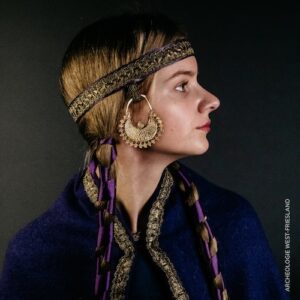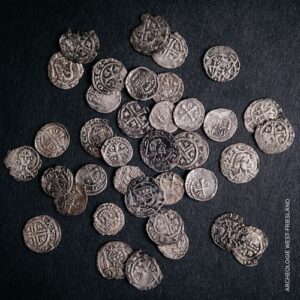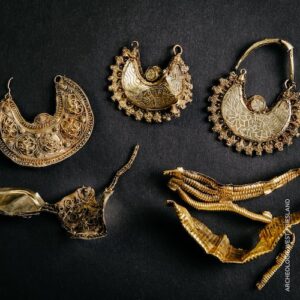
A model wears one the gold earrings suspended from a headband. Courtesy Archeologie West-Friesland
A spectacular find of ancient gold and silver by a 27-year old historian is now on display at the Rijksmuseum van Oudhed (National Museum of Antiquities) in Leiden in the Netherlands. Lorenzo Ruijter, the discoverer, told the BBC that he had been searching with metal detectors since he was a boy of 10 and that to find a medieval treasure was unbelievably exciting. Ruijter said he had been hunting that day for three hours near the town of Hoogwood in Friesland in the north of the Netherlands and was ready to go home when he made the discovery in on land that had been plowed for centuries.
The treasure consisted of four gold pendant earrings, gold leaf ornaments from about 1050 AD and 39 coins from the Diocese of Utrecht and from Germany in the time of King William II of the Holy Roman Empire, from several centuries later. One earring features a man’s head, believed represent Christ as “Sol Invictus”, the other pair has elaborate filigree decoration. The large earrings were found with fragments of textile, indicating they had been worn attached to a headband, typical of the period. There were remnants of a bag that held treasure together. Rijksmuseum van Oudhed staff theorized that the much earlier gold ornaments were the property of a very wealthy individual, who buried it and the coins together during ongoing wars between Holland and West Friesland.
“I have seen one of these pendants before, so I knew what it was when I found it… I looked it up and found it was from about 1050. There are many recognizable coins in it, so I looked up from which Count they were, from which Bishop,” said Ruijter.

Silver coins from the medieval hoard from the Diocese of Utrecht and from Germany in the time of King William II . 13-14th C CE, courtesy Archeologie West-Friesland.
Although he remains the legal owner, Ruijter said that the treasure was best placed in the Leiden Rijksmuseum van Oudhed. “It is visible for everyone since they are there. This treasure is so important it should be seen by everyone.” Ruijter said he had not had the treasure valued. “I am not really interested in the money value. I just want to know the story.”
Coincidentally, Ruijter’s academic work dealt with treasure as well; it focused on the 17th-century Dutch privateer Cornelis Jol, known as El Pirata and Pegleg.
Ruijter reported his find to Archeology West Friesland, and then lent the treasure to the Rijksmuseum van Oudhed, which spent the last two years researching and conserving the coins and ancient gold jewelry, asking Ruijter to keep his discovery secret. “That was the hardest part,” he said.
The treasure will be displayed at the museum in a temporary exhibit until June 2023 and then shown as part of a new exhibition, titled “The Year 1000” opening October 13.
In the Netherlands, as in other countries where the rule of law is well-established, there is a voluntary system for reporting archaeological and maritime finds, whether made by accidental discovery or by using a metal detector. Archaeologists working with the government are allowed up to six months to study the object. After that, if the object is not actually archaeological, the finder may simply keep it. If the object is archaeological, the finder must share half of the value of the object with the owner of the land on which it is found.

Two pairs of medieval earrings (one crushed, likely in centuries of plowing) and gold foil ornaments, all about 1050 CE, A model wears one the gold earrings suspended from a headband. Courtesy Archeologie West-Friesland.
The Government of the Netherlands has posted directions on reporting finds to the Minister van Onderwijs, Cultuur en Wetenschap – OCW (Minister for Education, Culture and Science). Finders must report discoveries of archaeological objects – defined as a valuable object that has been hidden for centuries and whose owner is no longer alive – on a form on the Rijksdienst voor het Cultureel Erfgoed (Cultural Heritage Agency) website.
If the discoverer of an archaeological object needs assistance, they can get help from an archaeological depot or an ArcheoHotSpot, or from someone who works for the local municipality who specializes in archaeology. Archaeological depots are found in regional centers. Archeohotspots were established in 2014; the first was located in the Allard Pierson Museum in Amsterdam. The public is encouraged to walk in – without an appointment – and get information on a found object for free.
The Netherlands also maintains a centralized database in which archaeologists can store data from maps to coring research to specialized research for dissertations – and students, scholars and the public can access it. The database includes work by Dutch archaeologists from around the world.
 Lorenzo Ruijter, the discoverer, at the findspot, courtesy Archeologie West-Friesland.
Lorenzo Ruijter, the discoverer, at the findspot, courtesy Archeologie West-Friesland. 

